Ceramic tiles are durable, practical, and timeless—but they don’t always match your evolving style. If your kitchen backsplash, bathroom walls, or tiled floor looks outdated, you don’t have to rip everything out. A fresh coat of the best paint for ceramic tile can completely transform your space without the cost of replacement. With the right paint, you can give your tiles a modern look, protect them from wear, and extend their lifespan.
But not all paints are created equal. Ceramic tile is smooth, glossy, and non-porous, which makes it difficult for standard wall or floor paint to adhere. Choosing the right formula ensures durability, resistance to moisture, and a professional-looking finish. That’s why understanding which type of paint to buy—and how to apply it—is crucial for success.
In this guide, we’ll break down the key factors to consider when buying paint for ceramic tile so you can confidently pick the best product for your project.
🛒 Buying Guide: How to Choose the Best Paint for Ceramic Tile
1. Paint Type
- Epoxy Paint: Extremely durable, moisture-resistant, and ideal for bathrooms, kitchens, and high-traffic floors. Harder to apply but long-lasting.
- Acrylic Latex Paint (with primer): Best for walls and low-traffic areas. Easier to apply but less durable than epoxy.
- Chalk Paint: Great for decorative finishes and DIY projects but requires a sealer for protection.
2. Tile Location & Use
- Floors: Require heavy-duty epoxy or tile-specific paints that can handle foot traffic.
- Walls & Backsplashes: Acrylic latex or enamel paints work well.
- Bathrooms & Kitchens: Go for moisture- and mold-resistant formulas.
3. Finish Options
- Glossy Finish: Reflective, easy to clean, but may highlight imperfections.
- Satin/Semi-Gloss: Balanced option—durable and slightly less reflective.
- Matte Finish: Trendy look but can be harder to maintain on high-traffic surfaces.
4. Durability & Resistance
Look for paints with:
- Scratch resistance for floors.
- Moisture and mold resistance for bathrooms.
- Stain resistance for kitchens.
5. Ease of Application
- Some paints require primers and sealers for best results.
- Others, like 2-part epoxy kits, are self-priming but need mixing and careful application.
- Consider your skill level and time before choosing.
6. Color Selection
- Lighter shades brighten small spaces but show dirt more easily.
- Darker tones add sophistication but can make a room feel smaller.
- Check if the brand offers a wide variety of tile-appropriate shades.
7. Budget & Coverage
- Higher-quality paints may cost more but often cover better and last longer.
- Compare coverage per gallon/quart to estimate how much you’ll need.
✅ Pro Tip: Always prep your tiles properly—clean, sand, and prime—to make sure the paint bonds and lasts for years.
1. DWIL Tub & Tile Paint Refinishing Kit (Water-Based, Low Odor, Semi-Gloss White)
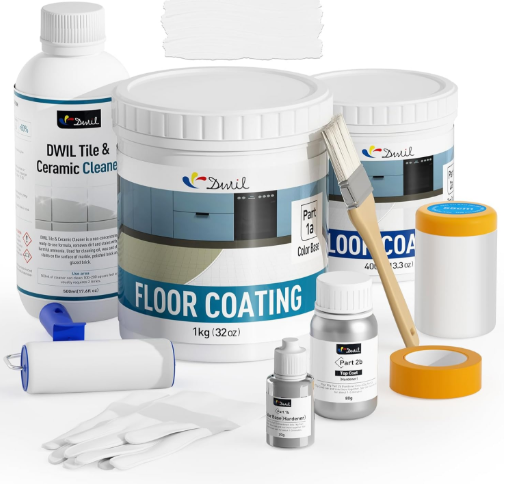
Product Description:
This is a refinishing kit designed for bathtub, tile, and ceramic surfaces. The DWIL kit typically includes a water-based paint, low odor formula, and applicator tools (brush or small roller). Covers about 25-30 square feet with one kit. The semi-gloss white finish aims to restore gloss, brighten up tile surfaces, and provide a fresh, clean appearance. Because it’s water-based, it’s easier to clean up and safer for indoor use.
Key Features:
- Low odor water-based formula — less harsh fumes.
- Semi-gloss white finish for tile, tub, etc.
- Includes tools for application.
- Coverage ~25-30 sq. ft per kit.
- Designed for adhesion to ceramic/glazed tile after proper prep.
Pros:
- Easy to use, reasonable coverage for small bathroom walls or small tile areas.
- Low odor makes it more tolerable, especially in areas without strong ventilation.
- Semi-gloss finish cleans fairly well.
- Good option for DIY-ers who want to update tile without full replacement.
Cons:
- One coat might show imperfections — multiple coats often needed.
- Semi-gloss white may show drips, brush marks, or surface irregularities.
- Durability is less than two-part epoxies; may chip or wear under heavy use (e.g. floors or high moisture).
- The finish might yellow slightly over time in some lighting, particularly if heat/steam exposure is heavy.
Recommendation:
A good choice if you have an older, dull ceramic tile area (like a bathtub surround or tile wall) that you want to freshen up. It’s best used in places with moderate moisture and where surface wear isn’t heavy. For tub surrounds, showers (with glazing), or backsplash, this could be a budget-friendly refresh. If you expect heavy foot traffic or constant exposure, consider reserving this type of paint for low-impact areas or as a temporary fix.
2. Giani Marble Easy Epoxy Countertop & Tile Paint Kit (Carrara White)
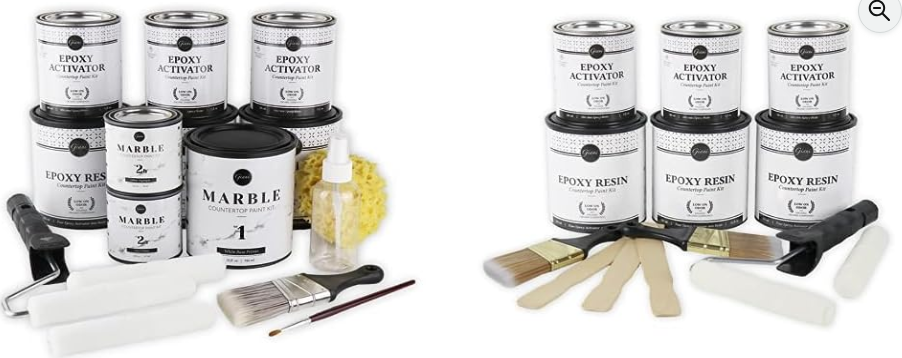
Product Description:
Giani’s Marble epoxy paint kit is marketed largely for countertops, but many versions work for ceramic tile as well. The kit includes epoxy base + hardener, mixing trays, applicators. The finish mimics marble (in this variant, “Carrara White”) giving a natural stone look over ceramic or other surfaces. Epoxy resin provides a harder, more glossy finish that is more durable than typical latex paints.
Key Features:
- Two-part epoxy system (resin + hardener) for added hardness and durability.
- Decorative “marble look” finish in Carrara White (speckling, streaking).
- Kit contains tools for mixing and applying.
- Designed for countertop/tile surfaces that need both function and aesthetics.
Pros:
- Attractive marble-like finish that can update tile dramatically.
- Epoxy provides better resistance to water, soap, mild abrasion.
- Because it’s a kit, you generally get all the necessary tools included.
- Once cured properly, it tends to last longer than regular tile paint.
Cons:
- More complex to apply: need good mixing ratios, application speed (once mixed), and good surface prep.
- Epoxy tends to have stronger odor, requires good ventilation.
- Higher cost than simple water-based kits.
- May take longer for full cure (several days) before heavy use.
Recommendation:
Best if you want a more premium finish and durability, perhaps for a kitchen backsplash, countertop tile, or a heavily used bathroom. Great for people who are comfortable with DIY, mixing, and working carefully. If patience and careful prep are part of the plan, this delivers good visual impact and longer life.
3. Rust-Oleum Tub & Tile Refinishing Kit
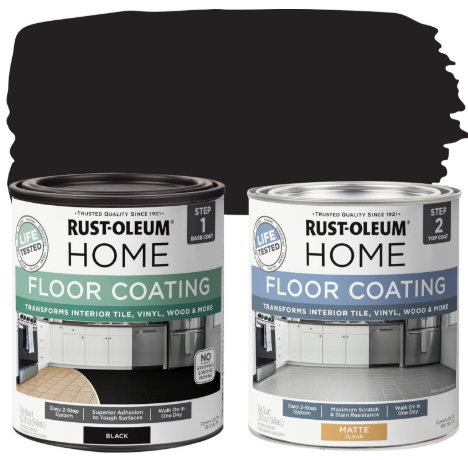
Product Description:
Rust-Oleum’s refinishing kits are fairly well known. They’re designed to restore glazed ceramic surfaces in bathrooms (bathtubs, tile, tile walls). Generally include epoxy enamel or acrylic enamel paint, adhesion promoter / primer, and possibly tools like brush or sweeper. They often offer good gloss and durable finish in high-moisture environments.
Key Features:
- Enamel/epoxy formulation specifically made for tub/tile surfaces.
- High gloss / gloss finish to match tile look.
- Usually includes primer/adhesion promoter.
- Designed for moisture-resistance (bathtub, tile installation).
Pros:
- Highly suitable for ceramic tile in bathrooms where moisture is heavy.
- Known brand with experience; fairly reliable performance when prep is done well.
- Finish tends to be glossy and helps brighten the look and hide wear.
- For tile walls or backsplash, gives a near new look without replacing tile.
Cons:
- Glossy enamel can highlight imperfections in tile grout or surface (chips, mildew).
- Requires excellent surface cleaning, sanding, degreasing before paint. Otherwise adhesion problems.
- Some Rust-Oleum kits are more durable than others; check reviews for peeling or yellowing complaints.
- Brush-on versions may have visible brush strokes unless rolled/leveled carefully.
Recommendation:
A solid go-to for bathroom or backsplash tile refinishing. If you have glazed ceramic tiles that are in okay shape but look tired, this will refresh them well. Be sure to follow all prep steps. Avoid using just for floors with heavy wear unless the kit is explicitly rated for floor use.
4. INSL-X Granite Grip Epoxy Paint for Tile / Porcelain
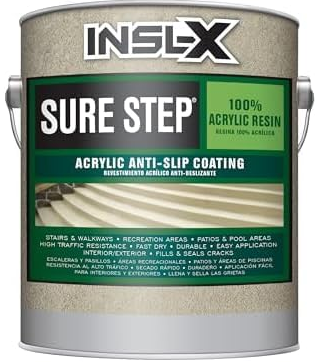
Product Description:
INSL-X Granite Grip or similar epoxy enamel paints are formulated to grip shiny/granite, glazed porcelain, ceramic tile surfaces. These paints often have an adhesion promoting formula, are epoxy modified, and intended to be used with sanding/deglossing. They produce a hard finish capable of resisting moisture and wear better than plain enamel paint.
Key Features:
- Epoxy modified enamel for better adhesion and durability.
- Made for glossy, hard, smooth surfaces (granite, tiles).
- Usually includes or requires sanding/deglossing before applying.
- Available in various colors / finishes.
Pros:
- Excellent adhesion on smooth tile surfaces (once properly prepped).
- Durable against moisture and mildew in bathrooms.
- Often simpler to apply (single component) compared to decorative epoxy kits.
- Good color options; can match with existing décor.
Cons:
- Surface prep is critical: sanding/deglossing, cleaning, maybe priming; skipping this causes peeling or flaking.
- Slight odor; fumes require ventilation.
- May be more costly per sq ft than basic acrylic paints.
- Finish could scratch if abused, especially in floors or areas of heavy furniture movement.
Recommendation:
Ideal if you want a paint that looks more like a traditional enamel finish but with better grip on tile surfaces. Great for tub surrounds, shower walls, ceramic splashbacks. If budget allows, choose multicolor options to suit interior design. Not always best for very large areas unless you are ready to spend on prep and materials.
5. Valspar Better Homes & Gardens Epoxy Door & Trim Paint (possible tile usage for trims/borders)
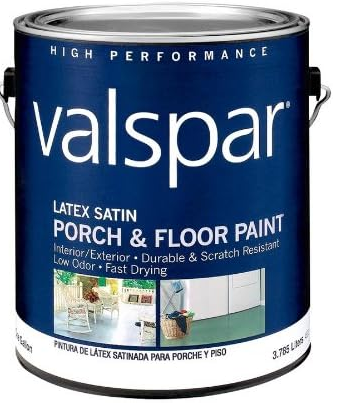
Product Description:
While not always marketed specifically for ceramic tile, Valspar’s epoxy enamel paint for doors & trims often works well in smaller tile-bordering uses, especially for ceramic tiles’ trim areas or accents. It offers a hardened finish and better durability than standard latex enamels.
Key Features:
- Epoxy/enamel formulation gives superior hardness.
- Meant for trim and door but sometimes suitable for tile edges or ceramic tile accents.
- Offers color variety.
- Durable gloss or semi-gloss finish.
Pros:
- Very hard finish, more resistant to scuffing.
- Good for smaller wood trim around tile or borders; can help tile butt edges look fresh.
- Many color options.
Cons:
- Not designed for full tile wall or bathtub tile exposure, so durability in full tile usage is less certain.
- Requires proper preparation (cleaning, potential primer).
- Some compatibility, adhesion issues on very slick glazes unless roughened first.
Recommendation:
Use this kind of paint if you need to touch up tile edges, trim, or accent areas rather than fully repainting tile walls/floors. For full tile surface painting, better to use product explicitly designed for tile or epoxy tile kits.
6. Behr Premium Multi-Surface Paint & Primer / Paint & Primer Enamel
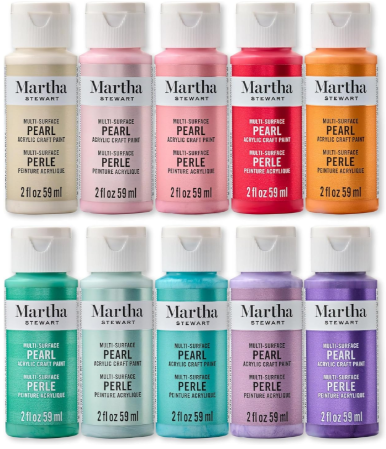
Product Description:
Behr’s multi-surface enamel paints often include options for tile surfaces, especially in interior settings. The paint + primer formula helps adhesion, and “premium enamel” finish adds durability. These are usually single component (no mixing) and come in a variety of finishes (satin, semi-gloss, gloss).
Key Features:
- Paint + primer built-in helps with adhesion on ceramic surfaces.
- Various finishes and color choices.
- Enamel finish (harder than flat or eggshell).
- Usually low VOC / low odor options.
Pros:
- Easier to apply than two-part kits.
- Good coverage; and color options help match décor.
- Less prep than epoxy kits (though still needs cleaning and degreasing).
- Available at many locations; more accessible.
Cons:
- Less durable than epoxy or epoxy-modified paint; can wear under heavy moisture or high traffic.
- May require top coat or sealer in heavy use areas.
- Gloss level may vary; peeled or scratched surfaces more visible.
- Not always rated for floors or constant wet exposure (e.g. inside showers).
Recommendation:
Good for moderate use areas: kitchen backsplashes, vanity tile, wainscoting, or accent tile panels. If using in high moisture or heavy traffic, ensure you pick enamel with strong adhesion and protect it (good sealant, proper caulking) to prolong life.
✅ Summary Comparison & What to Pick
| Need / Situation | Best Option Among Above |
|---|---|
| Highest durability & heavy moisture exposure | Giani Epoxy Kit or INSL-X Granite Grip Epoxy Paint |
| Decorative / fancy finish / aesthetics | Giani Marble Epoxy Kit |
| Small tile area or minimal budget | DWIL Tub & Tile Paint Kit or Behr Multi-Surface Enamel |
| Bathroom or tub / wet wall | Rust-Oleum or epoxy tile-specific enamel (e.g. INSL-X) |
| Accent or trim work | Valspar Epoxy/Enamel for trim & accents |
If you like, I can pull up 6 currently available Amazon products (with exact pricing / shipping to your area) so you can see side-by-side what’s in stock. Do you want me to do that?
🖌️ How to Use Ceramic Tile Paint
Painting ceramic tile isn’t like painting drywall—it requires prep, patience, and the right process. Here’s a step-by-step method for the best results:
1. Preparation is Key
- Clean Thoroughly: Wash tiles with a degreaser or trisodium phosphate (TSP) to remove grease, soap scum, or dirt.
- Repair Damage: Fill chips, cracks, or missing grout before painting.
- Sand the Surface: Lightly sand the glossy tile surface with 220-grit sandpaper to roughen it for better paint adhesion.
- Clean Again: Wipe down dust with a damp cloth and let dry.
2. Priming
- Use a tile bonding primer (epoxy or urethane-based) to help paint stick to the slick ceramic surface.
- Apply evenly with a brush or roller.
- Let it dry as recommended (usually 24 hours).
3. Painting the Tiles
- Stir paint thoroughly before use.
- Apply with a high-quality foam roller for smooth coverage; use angled brushes for grout lines and edges.
- Apply two thin coats rather than one heavy coat.
- Allow full drying time between coats (typically 6–24 hours).
4. Sealing (Optional but Recommended)
- Apply a clear polyurethane or epoxy topcoat for added durability—especially for floors, kitchens, or bathrooms.
- This helps resist scratches, moisture, and stains.
5. Curing
- Even after the surface feels dry, allow the paint to cure fully for 5–7 days before heavy use (especially on floors or showers).
⚠️ Safety Guide When Painting Ceramic Tile
✅ Do’s
- Work in a well-ventilated area — open windows and use fans to avoid inhaling fumes.
- Wear safety gear: gloves, goggles, and a respirator mask when sanding or using strong paints/primers.
- Tape off areas (like sinks, tubs, or countertops) to prevent accidental spills.
- Dispose of waste properly — rags, brushes, or rollers soaked in paint or solvents can be flammable.
- Read labels carefully — always follow manufacturer instructions for mixing, application, and drying times.
❌ Don’ts
- Don’t skip surface prep — paint will peel quickly without sanding and priming.
- Don’t use high heat tools near painted tiles; some paints can discolor.
- Don’t walk on freshly painted floors until the paint has fully cured.
- Don’t mix brands of primer, paint, and sealer unless the manufacturer confirms compatibility.
- Don’t leave paint or solvents within children’s reach.
❓ Frequently Asked Questions (FAQs)
1. Can you really paint ceramic tile?
Yes, you can. With the right prep—cleaning, sanding, priming, and sealing—ceramic tile can be painted successfully. The paint won’t be as durable as factory glaze, but with proper care, it can last for years.
2. What type of paint works best on ceramic tile?
Epoxy-based paints are the most durable, especially for floors and bathrooms. Acrylic latex paints can be used on walls and backsplashes, while chalk paint works for decorative projects (but needs sealing).
3. Do I need to use a primer before painting tile?
Yes. Ceramic tiles are smooth and non-porous, so primer is essential for good adhesion. Skipping primer can lead to peeling or flaking paint.
4. How long does painted tile last?
On walls and low-traffic areas, painted tile can last 3–5 years or more. On floors or showers, durability depends on prep, paint quality, and whether a protective sealer is applied.
5. Is painted tile waterproof?
The paint itself isn’t fully waterproof, but with a clear epoxy or polyurethane sealer, it can resist moisture and stains well. For showers or wet areas, sealing is highly recommended.
6. Can I paint floor tiles?
Yes, but only with durable epoxy or floor-specific tile paints. Even then, painted tile floors won’t be as tough as factory-finished tiles, so expect wear over time.
7. How should I clean painted tiles?
Use mild soap and a soft sponge. Avoid abrasive cleaners or scouring pads, which can scratch the surface and shorten the paint’s life.
🏁 Conclusion
Updating ceramic tile with paint is one of the most cost-effective home improvement projects. Instead of replacing outdated or dull tiles, the right paint can breathe new life into your kitchen, bathroom, or floors.
- For high-moisture areas like showers and tubs, epoxy paint is the best option.
- For backsplashes and walls, acrylic latex works well.
- For decorative projects, chalk paint plus a sealer adds style and versatility.
The key to success is proper surface preparation, primer, and sealing. With patience and the right products, painted ceramic tile can look fresh, modern, and stylish—without the cost of a full renovation.
✅ Bottom line: Choose the right paint for your project, follow safety and prep steps carefully, and you’ll enjoy a professional-looking finish that lasts for years.